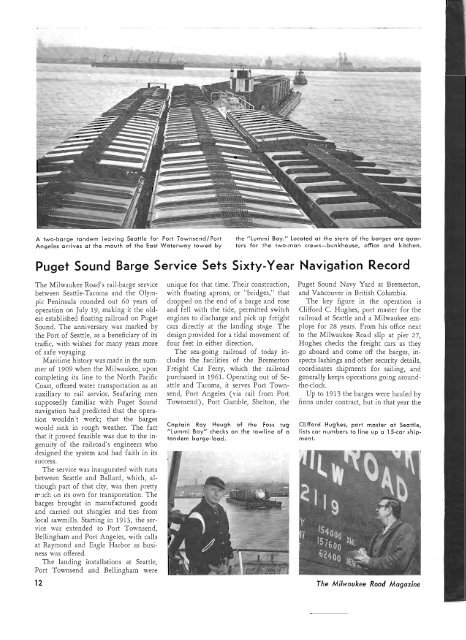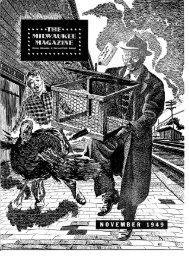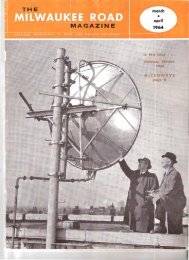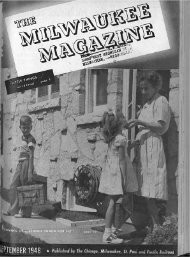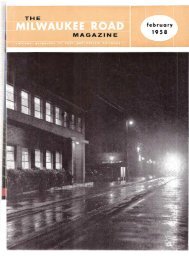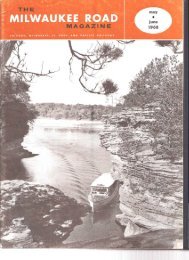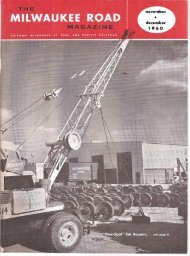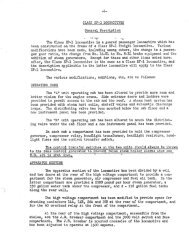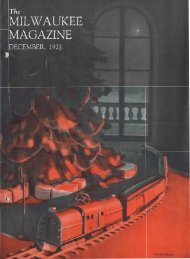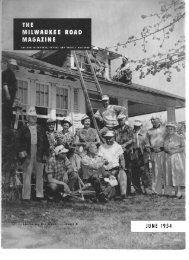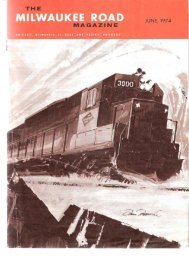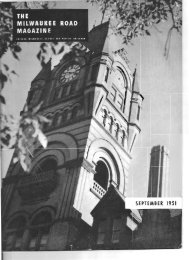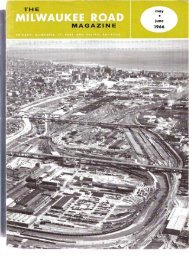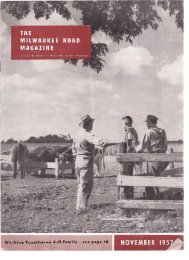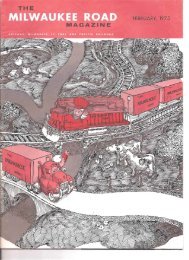July-August, 1969 - Milwaukee Road Archive
July-August, 1969 - Milwaukee Road Archive
July-August, 1969 - Milwaukee Road Archive
Create successful ePaper yourself
Turn your PDF publications into a flip-book with our unique Google optimized e-Paper software.
A two-barge tandem leaving Seattle for Port Townsend/Port the "Lummi Bay." Located at the stern of the barges are quar<br />
Angeles arrives at the mouth of the East Waterway towed by ters for the two-man crews-bunkhouse, office and kitchen.<br />
Puget Sound Barge Service Sets Sixty-Year Navigation Record<br />
The <strong>Milwaukee</strong> <strong>Road</strong>'s rail-barge service<br />
between Seattle-Tacoma and the Olympic<br />
Peninsula rounded out 60 years of<br />
operation on <strong>July</strong> 19, making it the oldest<br />
established floating railroad on Puget<br />
Sound. The anniversary was marked by<br />
the Port of Seattle, as a beneficiary of its<br />
traffic, with wishes for many years more<br />
of safe voyaging.<br />
Maritime history was made in the sum·<br />
mer of 1909 when the <strong>Milwaukee</strong>, upon<br />
completing its line to the North Pacific<br />
Coast, offered water transportation as an<br />
auxiliary to rail service. Seafaring men<br />
supposedly familiar with Puget Sound<br />
navigation had predicted that the operation<br />
wouldn't work; that the barges<br />
would sink in rough weather. The fact<br />
that it proved feasible was due to the ingenuity<br />
of the railroad's engineers who<br />
designed the system and had faith in its<br />
success.<br />
The service was inaugurated with runs<br />
between Seattle and Ballard, which, although<br />
part of that city, was then pretty<br />
IT''JCh un its own for transportation. The<br />
barges brought in manufactured goods<br />
and carried out shingles and ties from<br />
local sawmills. Starting in 1913, the service<br />
was extended to Port Townsend,<br />
Bellingham and Port Angeles, with calls<br />
at Raymond and Eagle Harbor as business<br />
was offered.<br />
The landing installations at Seattle,<br />
Port Townsend and Bellingham were<br />
12<br />
unique for that time. Their construction,<br />
with floating aprons, or "bridges," that<br />
dropped on the end of a barge and rose<br />
and fell with the tide, permitted switch<br />
engines to discharge and pick up freight<br />
cars directly at the landing stage. The<br />
design provided for a tidal movement of<br />
four feet in either direction.<br />
The sea-going railroad of today includes<br />
the facilities of the Bremerton<br />
Freight Car Ferry, which the railroad<br />
purchased in 1961. Operating out of Seattle<br />
and Tacoma, it serves Port Townsend,<br />
Port Angeles (via rail from Port<br />
Townsend), Port Gamble, Shelton, the<br />
Captain Roy Hough of the Foss tug<br />
"Lummi Bay" checks on the towline of a<br />
tandem barge-load.<br />
Puget Sound Navy Yard at Bremerton,<br />
and Vancouver in British Columbia.<br />
The key figure in the operation is<br />
Clifford C. Hughes, port master for the<br />
railroad at Seattle and a <strong>Milwaukee</strong> employe<br />
for 28 years. From his office next<br />
to the <strong>Milwaukee</strong> <strong>Road</strong> slip at pier 27,<br />
Hughes checks the freight cars as they<br />
go aboard and come off the barges, inspects<br />
lashings and other security details,<br />
coordinates shipments for sailing, and<br />
generally keeps operations going aroundthe-clock.<br />
Up to 1913 the barges were hauled by<br />
firms under contract, but in that year the<br />
Clifford Hughes, port master at Seattle,<br />
lists car numbers to line up a 15-car shipment.<br />
The <strong>Milwaukee</strong> <strong>Road</strong> Magazine


